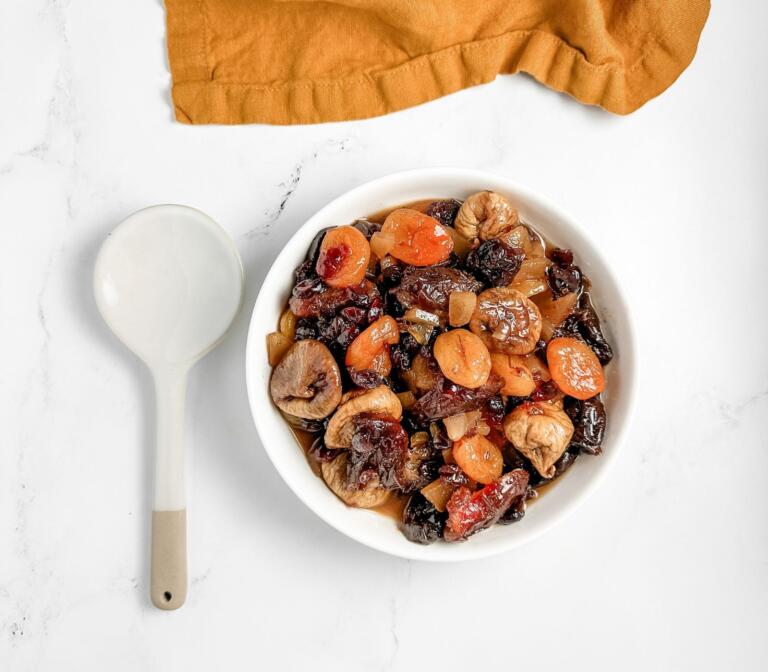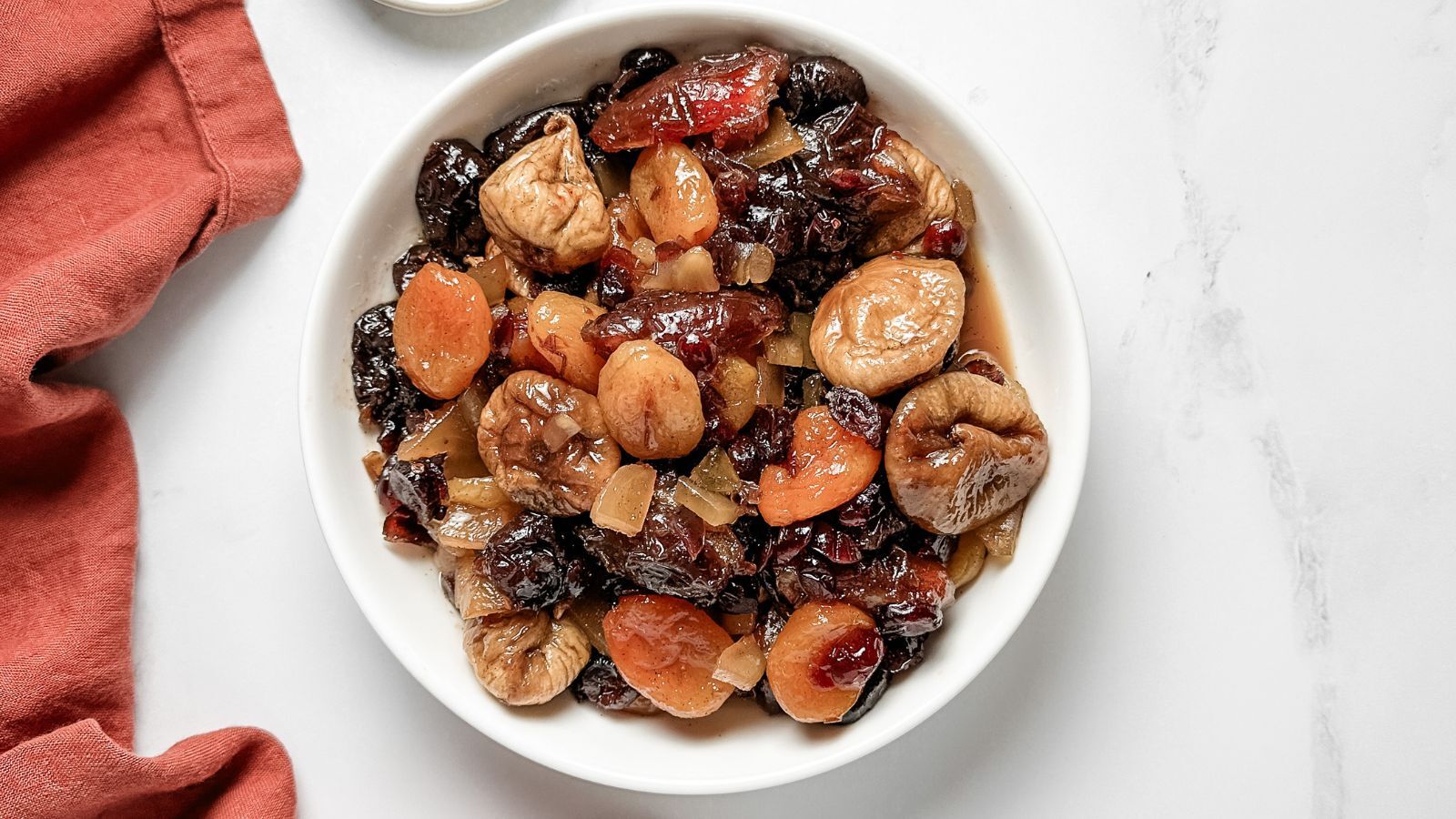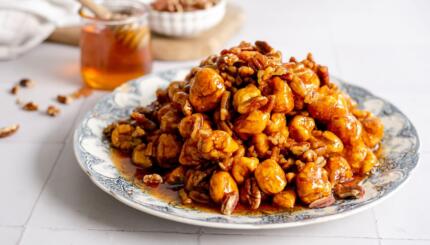There’s an essential comfort in recipes that come from our grandmothers.
For generations, they have passed down the love of family by cooking Jewish dishes. I think updating classic Jewish cuisine is a good way to make sure that love endures.
“Kumput,” was my grandmother’s Yiddish-accented name for stewed, dried fruit compote. When I was a kid, this dish was a staple in Ashkenazi homes. Everybody’s Jewish grandmother made it. It was especially popular at Passover, but some bubbes, like mine, made it all year.
In his book, “Encyclopedia of Jewish Food,” Gil Marks explains that sweetened, cooked fruit had long been prized in the Islamic world and that the method for cooking this sugar-laden favorite made its way to Europe by way of the usual trade routes. As the sugar beet became widely available in eastern Europe, the familiar dish that we know as “compote” became a regular in Jewish households.
The Nosher celebrates the traditions and recipes that have brought Jews together for centuries. Donate today to keep The Nosher's stories and recipes accessible to all.
Fresh produce was only available during warmer seasons of course, but our frugal ancestors preserved what was left by drying and storing fruit for the winter. Come Passover, the dried fruit was ready for cooking: sweet, deliciously bathed in syrup and also parve, making it the perfect dessert after a festive meal. And, as Joan Nathan points out, perfect for Shabbat, as you cook it ahead.
My grandma’s compote was made mostly with prunes. Sometimes, as an indulgence, she included the more costly dried apricots. I wasn’t a huge fan of her compote when I was a child, so I didn’t cook it until decades later, after a visit to Egypt. It was there I tried khoshaf, a dish similar to Ashkenazi compote, and found it to be smashingly delicious.
I started experimenting. I decided to jazz the dish up to be more stylishly modern and compelling, even for kids. I still used prunes and apricots, but also included a variety of dried fruit: figs, cranberries, dates, apples, cherries, raisins and mango. And I’ve changed my grandma’s recipe in other ways too: she cooked the fruit in lemony-sugared-water, but I use fruit juice (whatever kind I have in the fridge, usually mango, pineapple or orange juice) and, on occasion, have added some wine, usually sweet wine (such as a German Riesling). Grandma occasionally added some cinnamon; I’ve cooked the dish seasoned with cinnamon sticks, whole cloves, cardamom pods, vanilla beans, crystallized ginger and/or star anise. Occasionally I slip in a few whole peppercorns. I sometimes use sugar, but more often I make this compote with maple syrup or honey. The version below is my favorite.
These days I always have this compote in my fridge. We eat it frequently for breakfast with plain, Greek style yogurt. It’s also a treat over oatmeal or on top of pancakes or French Toast. But I’ve also served it with ice cream, whipped cream or sweetened mascarpone for dessert. A few times I’ve even pureed a small amount, stirred in some Sriracha and used it as barbecue sauce. This is a versatile dish with wide appeal.
And while it’s not my grandma’s “kumput,” I still think of her every time I make it.

Stewed Dried Fruit
While this recipe may be a blast from the past, it’s still delicious to this day.
- Total Time: 30-35 minutes
- Yield: 8
Ingredients
- 1 ½ cups water (or ¾ cup water plus ¾ cup sweet white wine)
- 1 ½ cups mango or apricot nectar or orange juice or orange/pineapple juice
- ¼ cup maple syrup
- 1 3” cinnamon stick
- 1 3” vanilla bean split open
- 2 Tbsp chopped crystallized ginger
- 6–8 whole dried figs
- 6–8 pitted Medjool dates
- 1 cup dried apricot halves
- 8–10 prunes
- ½ cup raisins or dried cranberries or cherries
Instructions
- Place the water, juice, maple syrup, cinnamon stick and vanilla bean in a saucepan large enough to hold all the dried fruit.
- Bring to a boil over high heat. Turn the heat to medium-low and simmer for 15 minutes.
- Add the fruit and simmer for another 15-20 minutes or until the fruit is soft. Let the fruit cool in the pan.
- Discard the cinnamon stick and vanilla bean. Let cool.
- Serve with the poaching liquid.
- Prep Time: 15 minutes
- Cook Time: 15-20 minutes
- Category: Dessert
- Method: One-pot
- Cuisine: Ashkenazi




How far in advance of serving can this be prepared?
Thanks
This can be prepared several days in advance.
I do a low calorie version in the microwave. Place fruit , lemon cut in quarters and cover with water. Cover dish and microwave on high until boiling. Add more water and microwave until boiling again. Remove from oven , cover dish with plastic wrap and let stand until cool. Refrigerate.
Mix with cooked sweet potatoes for a quick Tsimmes
This looks delicious. I always loved compote, but my bubbe cut up an entire lemon, sliced paper thin, that was my favorite part. She also used a bagged fruit mix that included dried pears. A very nice memory! I am intrigued by your spice mixture.